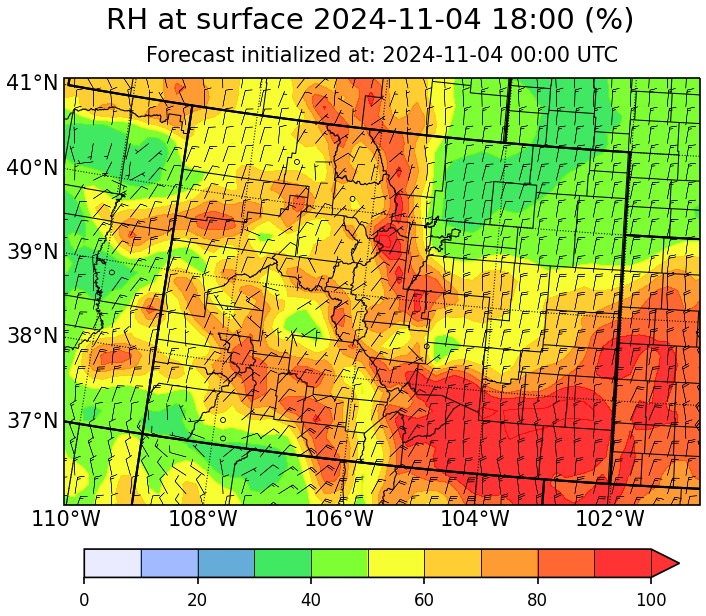WRF-Chem

WRF-Chem is the Weather Research and Forecasting (WRF) model coupled with Chemistry. The development of WRF-Chem has been a collaborative effort among the community, led by NOAA GSL. For more detail see the official WRF-Chem webpage (not reachable as of October 1, 2024).
Please be aware that in light of new model developments and due to resource constraints, WRF-Chem is no longer being developed. We continue to provide user support for the implemented suite of MOZART chemistry schemes and the provided preprocessing tools through our NSF NCAR ACOM User Forum. For all other questions we refer to the WRF-MPAS User Forum.
Daily forecasts of U.S. air quality for the next 48 hours are being provided with WRF-Chem. These forecasts use WACCM output for chemical boundary conditions and FINNv1-NRT fire emissions and are evaluated in near-real-time with U.S. EPA AirNow surface observations for ozone and PM2.5. MELODIES-MONET provides comparison maps of WRF-Chem and AirNow.
Global model simulations with the ability to have areas of the globe represented at regional scales is now available via the Multi-Scale Infratructure for Chemistry and Aerosols (MUSICA) project. We are also moving forward with implementing trace gases and aerosols in the Model for Prediction Across Scales (MPAS-A) model. Currently, resources for the MPAS-A with Chemistry development work are limited and there is no estimate when this development will be ready for the wider community for use and co-development.
UPDATES
March 2022 : An error was found in j_no3 in the MOZART chemistry options. In the mapping files (./chem/KPP/mechanisms/*jmap) the current assigment no3o : j_no3_a needs to be changed to no3o : j_no3_a + j_no3_b. After making this change a full recompile is needed.
February 2022: Thanks to Caterina Mogno (University of Edinburgh, UK) the recently released EDGARv5.0 emission inventory is now available in MOZART speciation for use with anthro_emiss. See this link for more information and to download the data set.
February 2022: A bug fix has been made to the epa_anthro_emis tool which corrects for an error in the mapping and specifically affected the results when mapping to higher resolutions. Thanks to a user for providing this fix.
October 2020: U.S.EPA NEI 2017 input data are now available for download. See TOOLS tab for more information.
ACOM WRF-Chem Developments for the Community |
||
| MOZART trace gas chemistry with GOCART aerosol scheme | Users Guide | |
|
MOZART trace gas chemistry with MOSAIC aerosol scheme |
Users Guide | |
| MOZART-T1 trace gas chemistry with GOCART aerosol scheme (new in V4.0) | Users Guide | |
| New TUV photolysis code (phot_opt = 4) Requires an additional data file; See Instructions for bug fix for WRFV3.9 and WRFV3.9.1: |
Instructions Additional Data File |
|
| Trajectories monitoring meteorology, chemistry, etc | Instructions | |
| Output of Integrated Reaction Rates (new in V4.0) IRR can be analyzed with PERMM Analysis Tool: |
Instructions PERMM Users Guide |
|
| Henry's Law Table (new in V4.0) | More Information | |
| EPA_ANTHRO_EMIS TOOL | See TOOLS tab for more information. |
Preprocessors
Go to TOOLS page for more information:
- US EPA anthropogenic emissions
- Global anthropogenic emissions
- MEGAN biogenic emissions
- FINN fire emissions
- Interpolate global model output for WRF-Chem initial and boundary conditions
Please see the Best Practices 2015 Tutorial Presentation that includes example namelists for running with MOZCART and MOZART-MOSAIC.
Submit questions regarding the tools and developments from our group to the WRF-Chem Discussion Forum.
For all other requests we refer to the WRF Forum.
WRF-Chem / DART
WRF-Chem/DART is being used for: (i) development of efficient satellite retrieval data assimilation methods (compact phase space retrievals); (ii) independent and joint assimilation of atmospheric composition and meteorological observations, and (iii) estimating/constraining emission with the state augmentation methods. WRF-Chem/DART is being applied to two field campaigns, FRAPPE and KORUS-AQ, for atmospheric composition forecasting and data assimilation research. WRF-Chem/DART is also being applied to the MarcoPolo - Panda project for regional air quality forecasting in China.
Download
New users may register and download WRF-Chem at the WRF Model Download page. Raw model output is available at the NCAR Research Data Archive (NCAR RDA ds340.0) for research purposes.